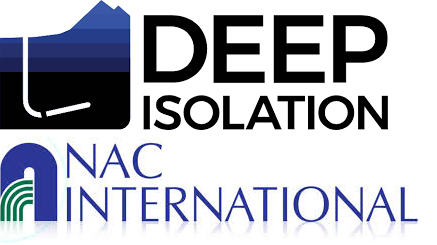Radioactive Waste 423 - Deep Isolation and NAC International Cooperate In Development Of Deep Borehole Nuclear Waste Disposal
One of the major problems with nuclear power is the disposal of the radioactive waste created by the burning of nuclear fuel in nuclear power reactors. There have been a variety of solutions proposed but the most widely supported solution is to bury the waste in deep holes where it would not be able to spread via migration of ground water. There are several different approached to exactly how and where to bury such waste. Deep Isolation (DI) and NAC International have agreed to cooperate on the design, development and manufacturing of DIs disposal canister technology.
Deep Isolation is a company based in Berkeley, California. They have been working on a solution to the disposal of spent nuclear fuel and high-level radioactive wastes. Their idea consists of drilling deep horizonal tunnels and filling them with corrosion resistant canisters containing the waste.
NAC International is a wholly owned subsidiary of Hitachi Zosen Corporation which has supplied a substantial proportion of the spent nuclear fuel systems that have been utilized to decommission U.S. utility sites. They have also developed and deployed transportable storage system for use by the U.S. Department of Energy (DoE) for moving nuclear waste to storage and disposal sites.
Elizabeth Muller is the CEO of DI. She said, “With NAC's global leadership and demonstrated canister safety and design expertise, we have an opportunity not only to further develop the safety and quality of our canister technology, but to implement a waste management strategy that covers onsite interim storage as well as handling, transport, and final disposal.”
Kent Cole is the President and CEO of NAC International. He has said that he believes that his company’s technology and expertise is a good fit with DIs disposal solution “to ensure storage, transport, and disposal objectives are well integrated into efficient waste disposition strategies, tailored to the relative size and needs of each country's nuclear power program”.
The agreement between DI and NAC is the second strategic Partnership that DI has entered into this year. The first partnership was with Bechtel International to develop, sell and deploy DI technology. Under its agreement with Bechtel, Bechtel will provide support for project management, financial/business and engineering consulting to assist both domestic and international sales. DI will provide assistance to support Bechtel’s cleanup work at U.S. DoE sites.
The DI approach to nuclear waste disposal calls for placing nuclear waste in corrosion-resistant canisters about twelve inches in diameter and fourteen feet long. These canisters are inserted into horizontal drill holes deep in rock strata that have been geologically stable for hundreds of millions of years. First a vertical access section anywhere from a few thousand feet to a few miles deep is drilled. This vertical section gradually curves to form a horizontal disposal section which could be as much as two miles long.
Once the canisters have been inserted to fill one of the two-mile horizontal tunnels, the vertical access section and the first part of the horizontal section will be filled with rock, bentonite and other materials. This layout is designed to permit eventual retrieval of the waste canisters should that be necessary.
DI says that the major advantage of their disposal system is the fact that the waste is buried deep, far below the water table. The rock where the waste is stored is saturated with brine that has no commercial value and has been virtually stagnate for millions of years. An additional benefit is that that small diameter of the bore holes does not disturb the rock as much as digging a mined repository such as the plan for Yucca Mountain to use an old salt mine. In January of this year, DI demonstrated their technology by inserting and retrieving a prototype nuclear waste canister more than two thousand feet underground in an existing borehole.
